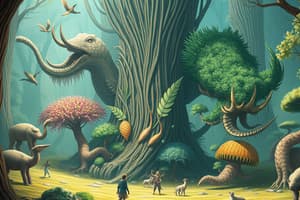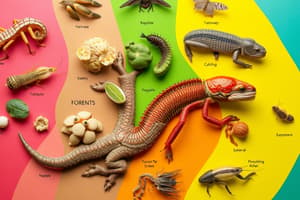Podcast
Questions and Answers
What is the primary purpose of the seven level classification system in biology?
What is the primary purpose of the seven level classification system in biology?
- To categorize organisms by their geographic location
- To group organisms based on their physical appearance
- To organize living organisms systematically for scientific study (correct)
- To determine the evolutionary relationships among organisms
Which kingdom of living organisms is primarily characterized by being unicellular or multicellular, eukaryotic, and primarily heterotrophic?
Which kingdom of living organisms is primarily characterized by being unicellular or multicellular, eukaryotic, and primarily heterotrophic?
- Plantae
- Protista
- Animalia (correct)
- Fungi
Which characteristic is most likely used to distinguish between different classes within the animal kingdom?
Which characteristic is most likely used to distinguish between different classes within the animal kingdom?
- The mode of locomotion (correct)
- The size of the organism
- The type of habitat
- The presence of vascular tissues
In the classification of living organisms, which of the following is the correct sequence from the broadest to the most specific category?
In the classification of living organisms, which of the following is the correct sequence from the broadest to the most specific category?
Which domain of life is known to include prokaryotic organisms that often thrive in extreme environments?
Which domain of life is known to include prokaryotic organisms that often thrive in extreme environments?
Flashcards are hidden until you start studying
Study Notes
5 Kingdoms of Living Organisms
- Kingdom Monera: Single-celled organisms without a nucleus (prokaryotes), including bacteria and blue-green algae.
- Kingdom Protista: Mostly single-celled eukaryotic organisms with a nucleus, including algae, protozoa, and slime molds.
- Kingdom Fungi: Multicellular, eukaryotic organisms that cannot produce their own food (heterotrophic), including mushrooms, molds, and yeasts.
- Kingdom Plantae: Multicellular, eukaryotic organisms that can produce their own food through photosynthesis (autotrophic), including trees, flowers, and ferns.
- Kingdom Animalia: Multicellular, eukaryotic organisms that cannot produce their own food (heterotrophic), and are motile, including mammals, birds, reptiles, amphibians, fish, and insects.
Seven Level Classification System
- Domain: The highest level of classification that categorizes organisms based on their fundamental cellular structure.
- Kingdom: Categorization of organisms based on broad similarities in their general characteristics, cell structure, and mode of nutrition.
- Phylum: Groups organisms within a kingdom based on their shared body plan and organization.
- Class: Groups organisms within a phylum based on shared structural and functional characteristics.
- Order: Groups organisms within a class based on similar traits like their reproductive systems and behavior.
- Family: Groups similar organisms within an order based on shared characteristics in their morphology, reproductive systems, and physiology.
- Genus: Groups closely related organisms within a family based on their shared evolutionary lineage and specific characteristics.
- Species: The most specific level of classification, grouping organisms that can interbreed and produce fertile offspring.
Diversity of Animals
- Characteristics: Multicellular, eukaryotic, heterotrophic, motile, with specialized tissues and organs for various functions.
- Classes:
- Mammals: Warm-blooded with fur or hair, give birth to live young, and nurse their offspring with mammary glands.
- Birds: Warm-blooded with feathers, lay eggs, and have wings for flight.
- Reptiles: Cold-blooded with scales, lay eggs, and have a three-chambered heart.
- Amphibians: Cold-blooded with smooth, moist skin, lay eggs in water, and undergo metamorphosis.
- Fish: Cold-blooded with fins, gills for breathing underwater, and lay eggs.
- Insects: Cold-blooded with exoskeletons, six legs, and usually wings.
Diversity of Plants
- Characteristics: Multicellular, eukaryotic, autotrophic, non-motile, with cell walls made of cellulose and different reproductive mechanisms.
- Types:
- Bryophytes: Non-vascular plants like mosses and liverworts, lacking specialized vascular tissue for transporting water and nutrients.
- Pteridophytes: Vascular plants including ferns, horsetails, and clubmosses, that use spores for reproduction.
- Gymnosperms: Vascular plants including conifers like pines and spruces, that have seeds but do not produce flowers.
- Angiosperms: Vascular plants that produce flowers and enclosed seeds within fruits.
Studying That Suits You
Use AI to generate personalized quizzes and flashcards to suit your learning preferences.




